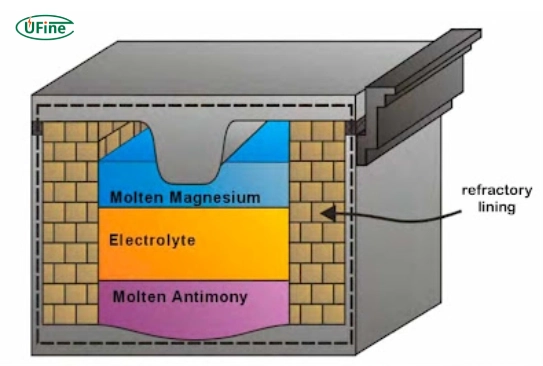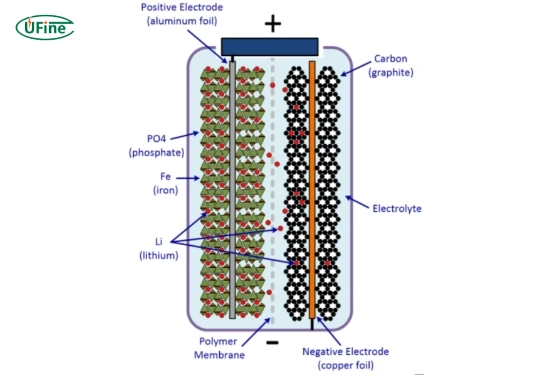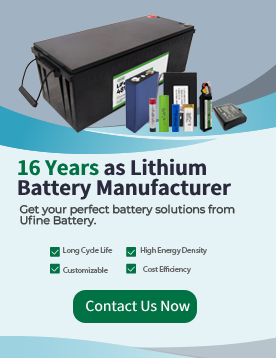Liquid metal battery vs lithium battery: comparative analysis is a hot topic among engineers, researchers, and investors alike. This article explores both battery types’ key features, working principles, and real-world applications. We discuss their advantages and limitations and insights into cost, sustainability, and future prospects.
Part 1. What is a liquid metal battery?
A liquid metal battery is an energy storage system that uses molten metals as electrodes and molten salt as electrolytes. The key idea is to keep the components liquid during operation. This design allows the battery to self-assemble into distinct layers that do not mix. The upper layer is usually a low-density metal, the middle layer is an electrolyte, and the bottom layer is a high-density metal. The liquid nature of the components enables quick ion transport and a robust cycle life. This design is beautiful for grid-scale energy storage, where durability and efficiency are essential.
The operation of a liquid metal battery is simple yet innovative. When the battery discharges, ions move from one metal to another through the electrolyte. During charging, the process reverses. Because the battery is entirely liquid, issues like electrode degradation are minimized, potentially leading to a longer operational lifespan. Researchers are excited by the idea because it opens up new ways to store energy on a large scale.
How does a liquid metal battery work?
Liquid metal batteries operate with a three-layer liquid structure. The top layer, often a low-density metal like sodium or a similar element, acts as the negative electrode. The bottom layer is a high-density metal serving as the positive electrode. In between, a molten salt electrolyte facilitates the flow of ions. When the battery discharges, ions move upward from the bottom electrode to the top, releasing electrons that flow through an external circuit. When charging, the reverse happens. The liquid nature of the battery components means that the interfaces between layers are self-healing, minimizing mechanical wear.
Part 2. What is a lithium battery?
Lithium batteries are one of the most widely used energy storage systems today. Unlike liquid metal batteries, lithium batteries use solid electrodes and a liquid or gel electrolyte. The lithium-ion technology is common in consumer electronics such as smartphones, laptops, and electric vehicles. The battery works by shuttling lithium ions between the anode and cathode during charging and discharging cycles.
The technology behind lithium batteries has been refined over many years, resulting in improved energy density and efficiency. However, there are concerns about safety and longevity. Issues such as thermal runaway and degradation over time can impact performance. Despite these challenges, lithium batteries remain popular due to their compact size, high energy output, and well-established manufacturing processes.
How does a lithium battery work?
Lithium batteries typically consist of a solid anode, a cathode made from lithium metal oxide, and a liquid or gel electrolyte. Lithium ions move from the anode to the cathode during discharging through the electrolyte. This flow of ions is accompanied by a transfer of electrons through the external circuit, which powers devices. When charging, a reverse current forces the ions back to the anode. The fixed, solid structure of the electrodes in lithium batteries makes them sensitive to mechanical stress and temperature changes, which can lead to degradation over time.
Part 4. Key differences between liquid metal and lithium batteries
Understanding the key differences between these two technologies is vital for anyone interested in energy storage solutions.
Material state:
- Liquid metal batteries use molten materials for electrodes and electrolytes.
- In contrast, lithium batteries use solid electrodes and a liquid or gel electrolyte.
Operating temperature:
- Liquid metal batteries operate at high temperatures to keep the metals fluid.
- Lithium batteries operate at room temperature or slightly above, which makes them more suitable for portable devices.
Cycle life:
- Due to their self-healing liquid structure, liquid metal batteries can achieve a longer cycle life.
- Though highly efficient, lithium batteries tend to degrade over time, especially under extreme conditions.
Energy density:
- Lithium batteries are known for their high energy density, making them ideal for applications where weight and size matter.
- Liquid metal batteries, however, are designed for stationary applications where volume and weight are less of a concern.
Safety:
- Lithium batteries have safety concerns, such as thermal runaway, which can lead to fires or explosions if not managed correctly.
- Liquid metal batteries avoid many of these issues while operating at high temperatures due to their unique design and the absence of flammable electrolytes.
Part 5. Advantages of liquid metal batteries
Liquid metal batteries offer several compelling benefits:
- High cycle stability: Their design minimizes electrode degradation. The liquid state allows for self-assembly, leading to a longer lifespan.
- Fast response times: The molten layers allow ions to move quickly. This fast ion transport means that these batteries can respond rapidly to changes in energy demand.
- Scalability: Liquid metal batteries are well-suited for grid-scale energy storage. As renewable energy sources become more prevalent, they can help stabilize the power grid by efficiently storing excess energy.
- Low maintenance: The self-healing nature of liquid metal layers reduces the need for frequent maintenance, which is essential for large-scale energy projects.
- Environmental resilience: Operating at high temperatures, these batteries are less sensitive to temperature fluctuations and can maintain performance in harsh environments.
Part 6. Advantages of lithium batteries
Lithium batteries continue to dominate many markets because of their inherent advantages:
- High energy density: Their compact size and high energy output make them ideal for portable devices and electric vehicles.
- Mature technology: With decades of development, lithium battery technology is well understood and widely manufactured. This maturity translates into reliability and cost-effectiveness for many applications.
- Wide application base: Lithium batteries power everything from smartphones to electric cars. Their versatility is one of the main reasons they have become the standard in many industries.
- Fast charging: Advances in lithium battery technology have led to improved charging speeds. This is particularly beneficial for consumer electronics and vehicles that need quick turnaround times.
- Cost efficiency: Over time, the cost of producing lithium batteries has decreased significantly. Mass production and technological improvements have made them affordable for various applications.
Part 7. Applications: Liquid metal battery vs lithium battery
Lithium-ion battery applications
- Consumer electronics (smartphones, laptops)
- Electric vehicles (EVs)
- Renewable energy storage
- Power tools
Liquid metal battery applications
- Grid-scale energy storage
- Renewable energy integration
- Industrial energy backup
While lithium-ion batteries dominate portable electronics and EVs, liquid metal batteries are designed for large-scale stationary storage.
Part 8. FAQs about liquid metal battery vs. lithium battery
Are liquid metal batteries better than lithium-ion batteries?
Liquid metal batteries are better for grid storage due to their long lifespan and cost-effectiveness. Lithium-ion batteries are superior for portable devices.
Why are lithium-ion batteries widely used?
They have high energy density, making them ideal for smartphones, laptops, and EVs.
Can liquid metal batteries be used in electric cars?
No, liquid metal batteries are unsuitable for EVs because they require high operating temperatures and are too heavy.
Are lithium-ion batteries bad for the environment?
Yes, lithium mining causes pollution, and recycling lithium batteries is challenging.
Will liquid metal batteries become mainstream?
They may dominate grid storage in the future but are unlikely to replace lithium-ion batteries in consumer electronics.
Related Tags:
More Articles

How to Choose the Best Floor Scrubber Battery for Commercial Cleaning?
Selecting the ideal floor scrubber battery ensures a long runtime, rapid charging, and minimal maintenance for efficient commercial cleaning operations.
Battery for Blower vs Battery for Leaf Vacuum: Which One Should You Choose?
Battery for blower vs leaf vacuum—learn the key differences in power, fit, and runtime to choose the right battery for your outdoor tool needs.
How to Choose the Right Battery for Blower?
Choosing the right blower battery? Consider voltage, capacity, chemistry & usage. This guide helps match the best battery for peak performance.
How to Choose the Best Insulated Battery Box for Lithium Batteries?
Choosing the Best Insulated Battery Box for Lithium Batteries? Discover key factors such as size, material, and safety for optimal protection and performance.
7 Critical Elements on a Lithium Battery Shipping Label
What must be on a lithium battery shipping label? Learn 7 key elements to ensure safety, legal compliance, and correct handling across all transport modes.





